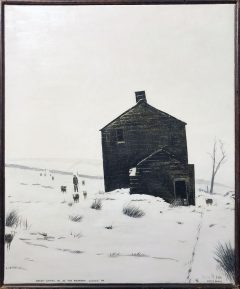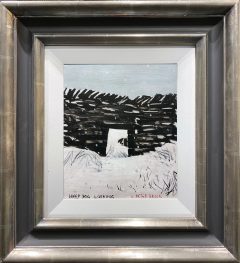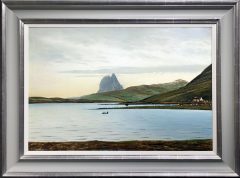Peter Brook (1927 - 2009)
Showing all 3 results
-

Peter Brook – Sheep Coming in as the Weather Closes In (Sold)
Read more -

Peter Brook – Sheep Dog Looking (Sold)
Read more -

Peter Brook – Three Men in a Boat (Sold)
Read more
Peter Brook
Peter Brook (1927 – 2009) The son of farmers, Peter Brook was brought up in West Yorkshire where he spent most of his life. He was educated at Barnsley Grammar School before moving on to teacher training at Goldsmiths College. Part of London University, where he visited galleries and attended life drawing evening classes. He further developed his art alongside his teaching career back in Yorkshire. On trips in the countryside with his art students he would tell them to use the same approach he used in his own painting: ‘if you want a subject, look around you’.
Brook became a full-time artist in his 40s and in 1962 was elected a member of the Royal Society of British Artists. Agnews, the major London art dealers, began to represent Peter in the late 1960s and their first two shows of his work resulted in over 100 paintings being sold. Further shows in America and Australia followed. In 1974 he was commissioned to design the Oxford University Almanac. Actors Tom Courtney and James Mason were big collectors of his work at this time
Yorkshire
The crumbling farmhouses on sheep-dotted moors sweeping into the distance, or people bustling round honey-stoned houses. Faithfully observed by the man and his dog, always provided Brook with the subject matter he desired. While he painted elsewhere in the British Isles, he continued to return to the Yorkshire Pennines, often in snowy winters. These wonderful painted snow scenes are now highly collectable.
Although his subjects remained consistent, Brook continued to work on his technique and approach. Having started out using thick paint, he started to use the very sandstone he painted. Crumbled to a fine dust and mixed with thinner paint to give more substance to his buildings. He was further inspired by the hazy effect of Victorian prints which led him to sometimes use rags, wire brushes or his fingers to conjure streaky clouds or smoky skies.
Humour
A dog’s face peeking through a gap in a door, or a quirkily placed sheep bring humour to Brook’s work. However the strength of his wit really comes through in the titles he inscribes along the bottom of his paintings. A revelatory comment or sometimes enigmatic description make the observer laugh or think and both provide a further dimension to the work and offer even more of the artist’s insight into the scene.
Brook’s impressions of the Yorkshire Pennines, moors, and mills seem deeply infused with the artist’s personality. His intimate knowledge of the seasons, stark landscape and fading customs of his homeland. Combined with his wit and varied, painterly touch make the paintings easily recognisable and instantly appealable.
He was a hugely successful artist during his lifetime and is now recognised as one of Yorkshire’s greatest artist. His work is in the Tate Collection, The V & A, Wakefield Art Gallery, Leeds City Art Gallery, Leeds University & Spring Ram PLC and in major private collections throughout the world. A whole series of books were published about his during his lifetime plus two major books after he died. Peter Brook – A Life in Painting Vol I & II.


